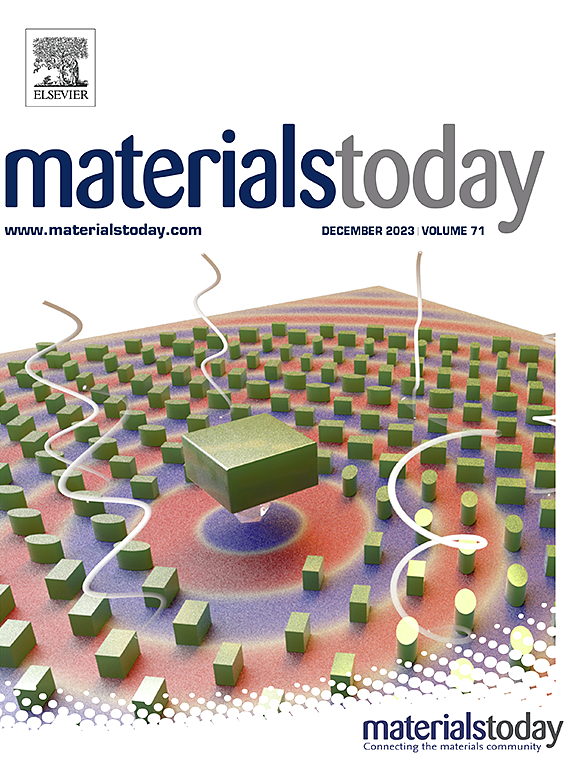Supersonic puncture-healable and impact resistant covalent adaptive networks
IF 21.1
1区 材料科学
Q1 MATERIALS SCIENCE, MULTIDISCIPLINARY
引用次数: 0
Abstract
The dynamic behavior of thin polymer films under high-rate deformation and at small length scales is quite different from that of macroscopic samples loaded quasi-statically. While self-healing of dynamic polymers is well documented for macroscopic samples under applied pressure, mild temperature, and prolonged times, self-healing at the nanoscale after extreme deformation at high rates is largely unexplored. We demonstrate the extensive puncture healing of furan/maleimide Diels-Alder polymer (DAP) covalent adaptive network (CAN) submicron thin films induced by supersonic micro-projectile impacts. For a given sample thickness to projectile size ratio, DAP submicron thin films display a significantly smaller perforation than glassy thermoplastics while showing adequate kinetic energy absorption. Post-mortem microscopic examination reveals efficient puncture healing that is enabled by spatiotemporal gradients in stress- and temperature-induced thermomechanical responses of DAP networks. These responses include a unique solid-to-liquid transition, in addition to viscoelasticity and viscoplasticity. Dissociation of DA bonds occurs due to adiabatic heating and high stresses. The partially dissociated network undergoes biaxial stretching until perforation with subsequent entropically-driven elastic recovery helping puncture closure. Infrared nanospectroscopy confirms that the chemical structure of DAP networks surrounding the puncture has recovered to that before the impact. The energy absorption is evaluated using in-situ imaging at nanosecond, micron-scale resolution. This work suggests molecular design principles for advanced self-healable, damage-tolerant, and energy-absorptive materials that withstand ballistic impacts.

超声速刺愈合和抗冲击共价自适应网络
聚合物薄膜在高速变形和小长度尺度下的动态行为与宏观样品在准静态加载下的动态行为有很大不同。虽然动态聚合物在施加压力、温和温度和长时间下对宏观样品的自修复有很好的记录,但在高速率极端变形后的纳米级自修复在很大程度上尚未被探索。我们证明了呋喃/马来酰亚胺Diels-Alder聚合物(DAP)共价自适应网络(CAN)亚微米薄膜在超音速微弹丸撞击下的广泛穿刺愈合。对于给定的样品厚度与弹丸尺寸比,DAP亚微米薄膜的穿孔明显小于玻璃热塑性塑料,同时具有足够的动能吸收。死后显微检查显示,有效的穿刺愈合是由应力和温度诱导的DAP网络的热力学响应的时空梯度实现的。除了粘弹性和粘塑性之外,这些响应还包括独特的固-液转变。由于绝热加热和高应力,DA键发生解离。部分分离的网络进行双轴拉伸,直到射孔,随后熵驱动的弹性恢复有助于射孔闭合。红外纳米光谱证实,在穿孔周围的DAP网络的化学结构已经恢复到撞击前的结构。利用纳秒级、微米级分辨率的原位成像来评估能量吸收。这项工作提出了先进的自我修复、损伤容忍和能量吸收材料的分子设计原则,这些材料可以承受弹道冲击。
本文章由计算机程序翻译,如有差异,请以英文原文为准。
求助全文
约1分钟内获得全文
求助全文
来源期刊

Materials Today
工程技术-材料科学:综合
CiteScore
36.30
自引率
1.20%
发文量
237
审稿时长
23 days
期刊介绍:
Materials Today is the leading journal in the Materials Today family, focusing on the latest and most impactful work in the materials science community. With a reputation for excellence in news and reviews, the journal has now expanded its coverage to include original research and aims to be at the forefront of the field.
We welcome comprehensive articles, short communications, and review articles from established leaders in the rapidly evolving fields of materials science and related disciplines. We strive to provide authors with rigorous peer review, fast publication, and maximum exposure for their work. While we only accept the most significant manuscripts, our speedy evaluation process ensures that there are no unnecessary publication delays.
 求助内容:
求助内容: 应助结果提醒方式:
应助结果提醒方式:


